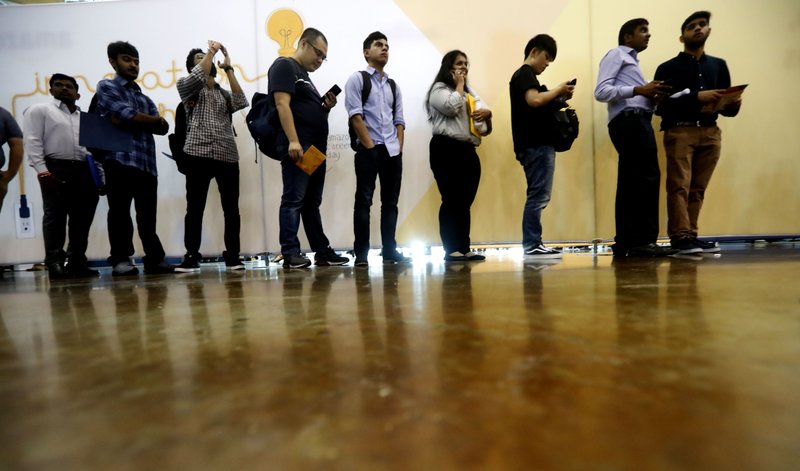WASHINGTON -- The U.S. economy added a modest 136,000 jobs in September, a gain that managed to lower the unemployment rate to a new five-decade low of 3.5% but also suggested rising caution among employers.
The additional hiring and the drop in the joblessness rate will likely ease worries that an economy weakened by the U.S.-China trade war and slower global growth could be edging toward a potential recession. The government on Friday also revised up its estimate of job growth in July and August by a combined 45,000.
Still, a drop-off in the pace of hiring compared with last year points to rising uncertainty among employers about the job market and the economy in the face of numerous trade conflicts. Pay growth has also weakened, reflecting the hesitance of employers to step up wages.
"The September jobs report sent some conflicting signals, but the big picture remains one of a labor market -- and an economy -- whose growth is downshifting but not collapsing," said Michael Feroli, an economist at JPMorgan Chase.
The comparatively sluggish hiring data makes it likely that the Federal Reserve later this month will cut rates for the third time this year to try to help sustain the expansion, some economists say. At the same time, the drop in the unemployment rate from 3.7% may embolden some Fed officials who have resisted rate cuts.
Investors appeared pleased that the jobs report at least suggested that the economy remains resilient for now. The Dow industrial average rose 372.68 points, or 1.4%, to end the week at 26,573.72.
Excluding government hiring, job gains over the past three months have slowed to an average of 119,000 a month, the weakest showing in seven years.
"Overall [the report] is a bit of a mixed bag," Torsten Slok, Deutsche Bank Securities chief economist, said on Bloomberg Television. But the main payroll number along with weakness in manufacturing add to signs that the trade war is putting "downward pressure both on hiring and the economy."
Despite ultra-low unemployment, average wages dipped in September, the Labor Department said. Hourly pay rose just 2.9% from a year earlier, below the 3.4% year-over-year gain at the start of the year.
Julia Pollak, a labor economist at jobs marketplace ZipRecruiter, said the pay that employers are advertising has declined this year after rising sharply in 2018. And she noted that the number of part-time workers who would prefer full-time work has risen over the past two months.
Those trends "show that employers are increasingly risk-averse as global uncertainty and recession fears rise," Pollak said.
A decline in job creation was expected now that the economic recovery from recession has passed its 10-year anniversary, and there are more job postings than job seekers. The unemployment rate has remained below 4% for the past seven months. And many Americans who had dropped out of the labor force because they were too discouraged to look for work or couldn't find sufficiently attractive offers have now rejoined.
More than 80% of Americans between the prime working ages of 25 and 54 were employed, the highest level since 2007.
MANUFACTURING JOBS
Still, the jobs report contained enough conflicting data that optimists and pessimists could find evidence to support their outlook.
Carl Tannenbaum, chief economist at Northern Trust, described the latest report as reassuring. "All of us have been on edge a little bit with declines on readings in the service sector, fearing that the trade problems would jump the fence from heavy to lighter industries," he said.
The weakest sector of the U.S. economy -- manufacturing, which is likely already in recession -- cut 2,000 jobs in September.
Trump has repeatedly placed the manufacturing sector at the center of his economic strategy. Nonetheless, that sector is suffering the most from prolonged trade tensions. Companies in the business of making goods -- as opposed to those that deliver services, such as hospitals and restaurants -- are much more dependent on sales to other countries and supply chains that wend around the globe.
Last spring, manufacturers were adding as many as 25,000 jobs a month. In recent months, the average has been a few thousand.
Factory employment may be poised to fall further in coming months with General Motors Co. workers on strike. About 46,000 employees walked out Sept. 15, which was too late in the month to be captured in the Labor Department's survey but may affect readings for October. At the same time, the strike may already be affecting wages and hours worked.
Becky Frankiewicz, president of staffing firm ManpowerGroup North America, is not convinced that trade friction is responsible for that drop.
"The number of manufacturing jobs we have open outpaces the number of candidates," she said. "It's become more difficult to fill a job in the last four months," she added.
The big job gains last month were in health care, which added 41,400 jobs, and professional and business services, which include such higher-paying areas as engineering and accounting but also lower-paying temp work. That sector added 34,000 positions.
Friday's jobs data highlighted the benefits of a hot job market for lower-paid Americans and traditionally disadvantaged workers. The unemployment rate for workers without high school diplomas fell to 4.8%, the lowest level on records dating to 1992.
Amy Glaser, senior vice president at Adecco USA, a staffing firm, said companies are still willing to raise pay for blue-collar workers. Some are also paying retention and signing bonuses and in some cases double pay for overtime.
"We're still seeing strong demand, we're still seeing more job opportunities out there than candidates," Glaser said.
Information for this article was contributed by Christopher Rugaber of The Associated Press; by Patricia Cohen of The New York Times; and by Katia Dmitrieva of Bloomberg News.
A Section on 10/05/2019
